
Mastering Nuance: The Indispensable Role of Adjectives Worksheets (Comparative, Superlative)
In the intricate tapestry of the English language, adjectives serve as the vibrant threads that add color, depth, and precision to our descriptions. They allow us to paint vivid pictures with words, differentiating between similar objects, expressing emotions, and making comparisons that enrich our communication. However, merely knowing what an adjective is isn’t enough; true mastery lies in understanding how adjectives change to express varying degrees of qualities – a concept beautifully encapsulated by comparative and superlative forms. For learners and educators alike, adjectives worksheets (comparative, superlative) are not just supplementary materials; they are foundational tools that unlock a deeper, more nuanced understanding of English grammar.
The Foundation: Understanding Adjectives
Before delving into the complexities of comparative and superlative forms, it’s essential to have a solid grasp of what adjectives are. At their core, adjectives are words that describe or modify nouns and pronouns. They answer questions like "What kind?", "Which one?", or "How many?". For example, in "the red car," "red" describes the car. In "a tall building," "tall" describes the building.

Adjectives add detail and specificity, transforming bland statements into engaging narratives. Without them, our language would be remarkably simplistic and lack expressive power.
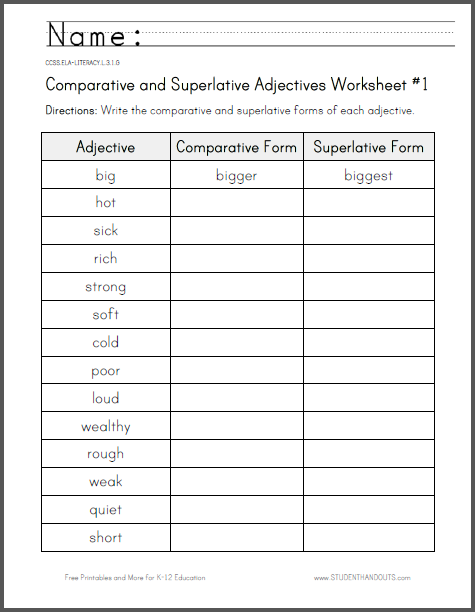
Stepping Up: Comparative Adjectives
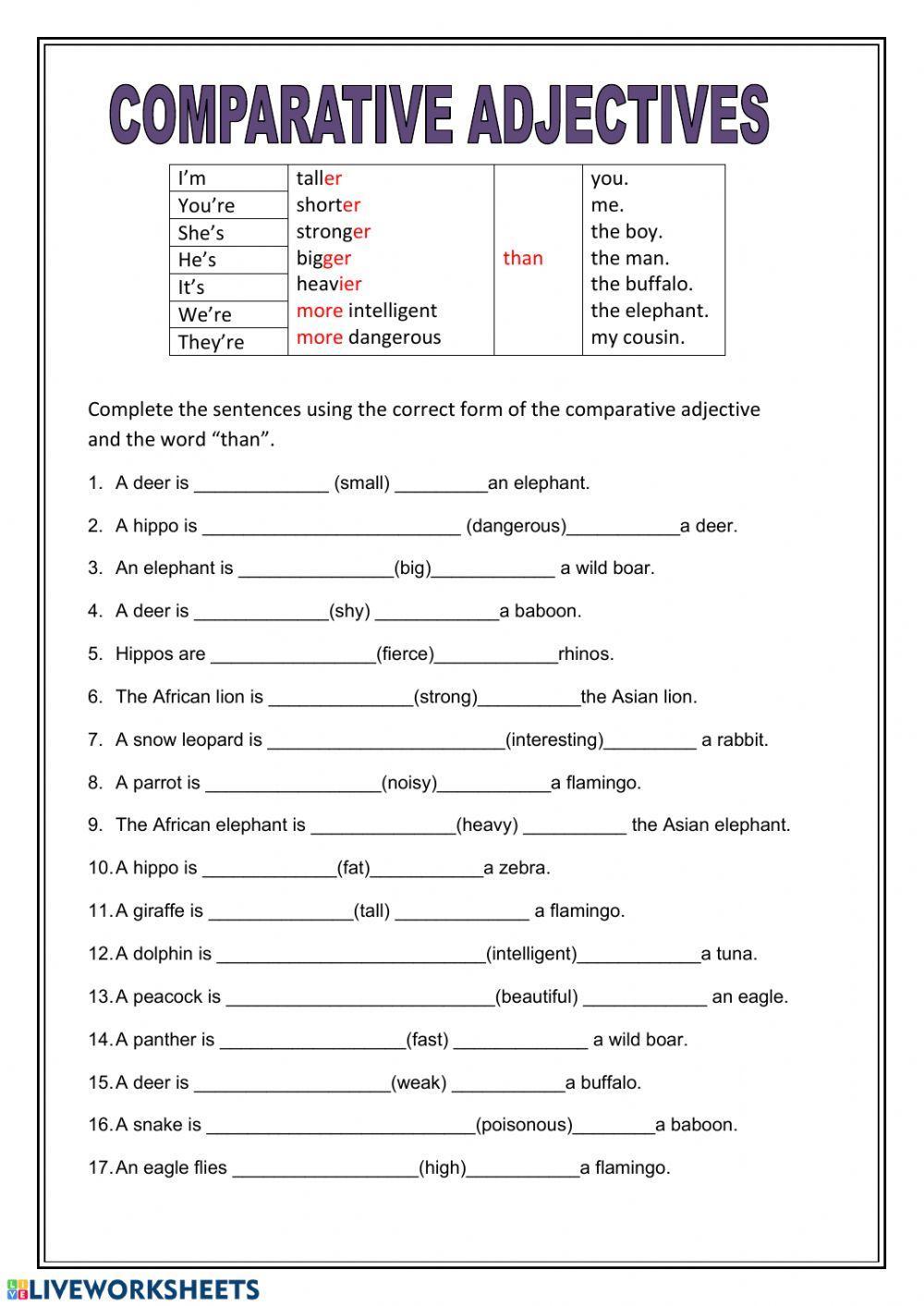
When we want to compare two nouns or pronouns, we use comparative adjectives. These forms indicate that one thing possesses a quality to a greater or lesser degree than another. The rules for forming comparative adjectives largely depend on the number of syllables in the adjective:
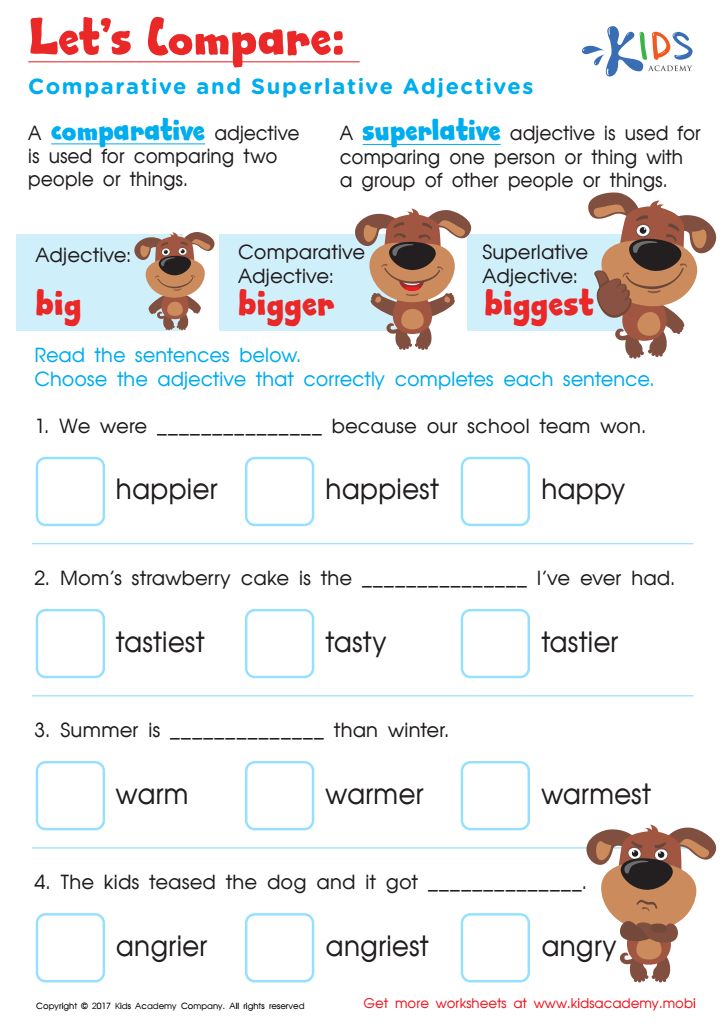
-
One-Syllable Adjectives: Typically, we add "-er" to the end of the adjective.
- Tall becomes taller (e.g., "John is taller than Mike.")
- Small becomes smaller (e.g., "My dog is smaller than yours.")
- Old becomes older (e.g., "This book is older than that one.")
- Big becomes bigger (e.g., "An elephant is bigger than a mouse." – Note the doubling of the consonant before -er if the word ends in CVC pattern).
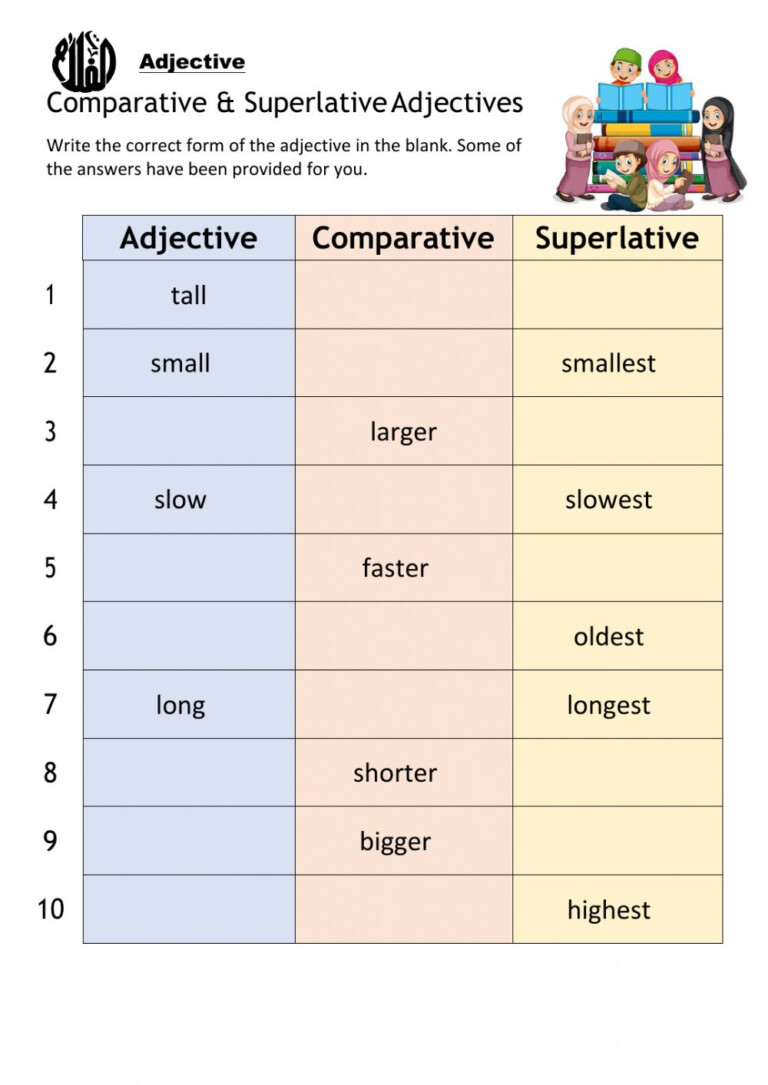
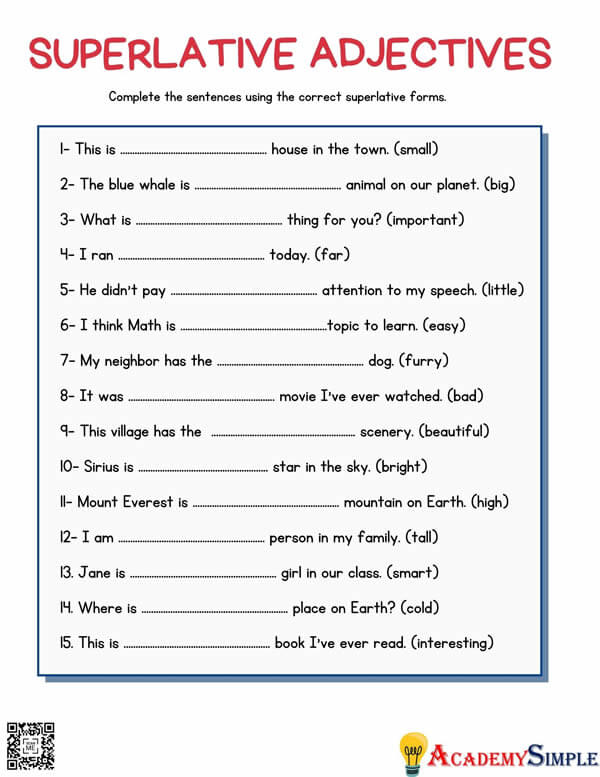
-
Two-Syllable Adjectives Ending in "-y": Change the "y" to "i" and add "-er."

- Happy becomes happier (e.g., "She looks happier today.")
- Easy becomes easier (e.g., "This test was easier than the last one.")
- Pretty becomes prettier (e.g., "My sister is prettier than me.")
-
Two or More Syllable Adjectives (not ending in "-y"): Use "more" before the adjective.
- Beautiful becomes more beautiful (e.g., "This painting is more beautiful than the other.")
- Important becomes more important (e.g., "Health is more important than wealth.")
- Expensive becomes more expensive (e.g., "That car is more expensive than this one.")
-
Irregular Comparatives: Some adjectives have irregular comparative forms that do not follow the standard rules. These must be memorized.
- Good becomes better (e.g., "Your English is better now.")
- Bad becomes worse (e.g., "The weather got worse.")
- Far becomes farther or further (e.g., "New York is farther than Boston from here.")
- Little (amount) becomes less (e.g., "I have less money than you.")
- Much/Many becomes more (e.g., "She has more patience than him.")
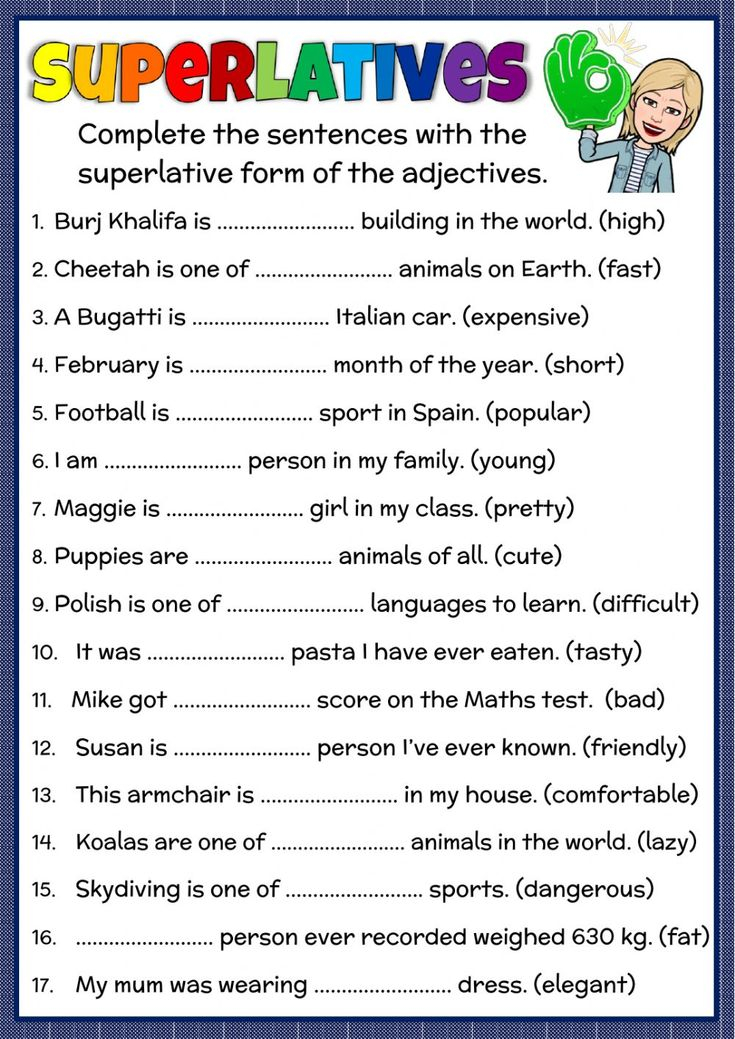
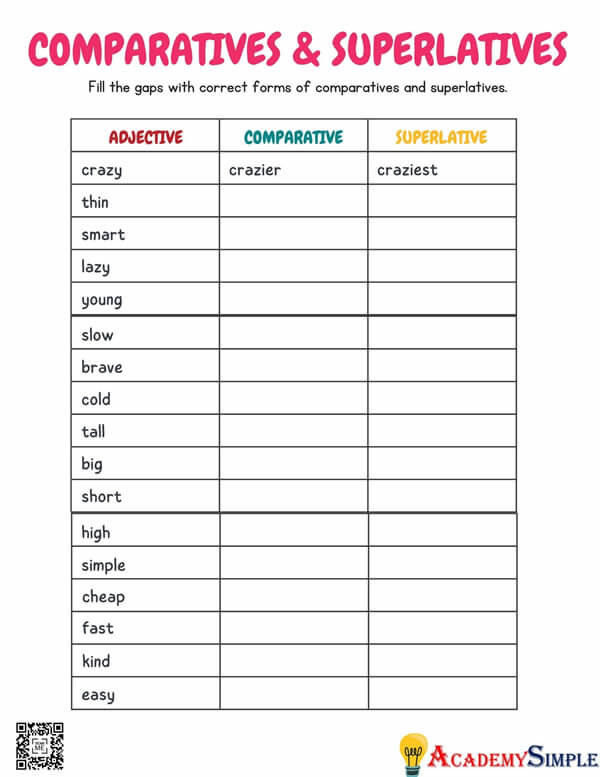
Mastering these rules is critical for constructing grammatically correct and meaningful comparisons.
Reaching the Peak: Superlative Adjectives
When we want to compare three or more nouns or pronouns and indicate which one possesses a quality to the highest or lowest degree, we use superlative adjectives. These forms often imply "the most" or "the least" of a certain quality within a group. The rules for forming superlative adjectives largely mirror those for comparatives:
-
One-Syllable Adjectives: Typically, we add "-est" to the end of the adjective and usually precede it with "the."
- Tall becomes the tallest (e.g., "He is the tallest student in the class.")
- Small becomes the smallest (e.g., "This is the smallest room in the house.")
- Old becomes the oldest (e.g., "She is the oldest person I know.")
- Big becomes the biggest (e.g., "The elephant is the biggest land animal.")
-
Two-Syllable Adjectives Ending in "-y": Change the "y" to "i" and add "-est."
- Happy becomes the happiest (e.g., "She was the happiest bride.")
- Easy becomes the easiest (e.g., "This was the easiest question on the exam.")
- Pretty becomes the prettiest (e.g., "That is the prettiest dress I’ve seen.")
-
Two or More Syllable Adjectives (not ending in "-y"): Use "most" before the adjective.
- Beautiful becomes the most beautiful (e.g., "The peacock is the most beautiful bird.")
- Important becomes the most important (e.g., "This is the most important decision of your life.")
- Expensive becomes the most expensive (e.g., "That sports car is the most expensive in the showroom.")
-
Irregular Superlatives: These forms, like their comparative counterparts, must be memorized.
- Good becomes the best (e.g., "He is the best player on the team.")
- Bad becomes the worst (e.g., "That was the worst movie ever.")
- Far becomes the farthest or the furthest (e.g., "This is the farthest I’ve ever run.")
- Little (amount) becomes the least (e.g., "She has the least amount of work to do.")
- Much/Many becomes the most (e.g., "He received the most votes.")
Understanding and correctly applying these rules for superlative adjectives allows speakers and writers to express extremes and pinpoint the unique quality of one item within a group.
Why Adjectives Worksheets (Comparative, Superlative) Are Indispensable
Given the varying rules and irregular forms, mastering comparative and superlative adjectives can be challenging. This is precisely where adjectives worksheets (comparative, superlative) become an invaluable asset in the learning process. They provide a structured, systematic, and repetitive approach that is crucial for internalizing these grammatical concepts.
- Reinforcement of Rules: Worksheets offer repeated exposure to the rules of formation. Through exercises like fill-in-the-blanks, sentence transformation, and multiple-choice questions, learners are forced to apply the rules consistently, reinforcing their understanding.
- Practical Application: Grammar rules, when learned in isolation, can feel abstract. Worksheets provide practical contexts where students can apply what they’ve learned, moving from theoretical knowledge to functional language use.
- Identification of Common Errors: Teachers can quickly identify patterns of errors in student responses, pinpointing specific areas of confusion (e.g., consistent misuse of "more" with one-syllable adjectives, or forgetting the definite article "the" before superlatives). This allows for targeted remediation.
- Building Confidence: Successfully completing exercises on worksheets builds confidence. As students see their accuracy improve, they become more willing to experiment with these forms in their spoken and written English.
- Catering to Different Learning Styles: Worksheets can be designed to appeal to various learning styles. Visual learners benefit from charts and matching exercises, kinesthetic learners can engage with cut-and-paste activities, and auditory learners can use worksheets as prompts for speaking exercises.
- Structured Practice: Unlike unstructured conversation, worksheets provide a controlled environment where learners can focus solely on the grammatical point at hand without being overwhelmed by other linguistic demands.
- Assessment and Progress Tracking: Worksheets serve as excellent tools for formative assessment. Teachers can use them to gauge student comprehension and track progress over time, adjusting their teaching strategies as needed.
Diverse Activities in Adjectives Worksheets (Comparative, Superlative)
Effective adjectives worksheets (comparative, superlative) incorporate a variety of activity types to keep learners engaged and address different aspects of the grammar point:
- Fill-in-the-Blanks: Students complete sentences by choosing the correct comparative or superlative form of a given adjective.
- Example: "My brother is (tall) __ than me." (taller)
- Example: "This is (good) __ movie I’ve ever seen." (the best)
- Sentence Transformation: Students rewrite sentences, changing positive adjectives into comparative or superlative forms.
- Example: "The red car is fast. The blue car is faster."
- Example: "Mount Everest is a high mountain. It is the highest mountain in the world."
- Error Correction: Students identify and correct mistakes in sentences that misuse comparative or superlative forms.
- Example: "She is more taller than her sister." (Incorrect) -> "She is taller than her sister." (Correct)
- Picture-Based Activities: Learners describe differences or extremes between objects or people depicted in images, using comparative and superlative adjectives. This is particularly effective for visual learners and younger students.
- Matching Exercises: Students match adjectives with their correct comparative and superlative forms, or match sentences with the appropriate comparative/superlative structure.
- Writing Prompts: Students use comparative and superlative adjectives to write short paragraphs describing family members, favorite places, or comparing different products.
- Dialogue Creation: Students work in pairs to create short dialogues that naturally incorporate comparative and superlative adjectives, simulating real-life conversations.
- Sorting/Categorizing: Students sort adjectives into categories based on how their comparative and superlative forms are made (e.g., add -er/-est, use more/most, irregular).
Designing and Utilizing Effective Worksheets
When creating or selecting adjectives worksheets (comparative, superlative), consider the following:
- Clear Instructions: Ensure the instructions are simple, direct, and easy for students to understand.
- Varied Difficulty: Start with simpler exercises and gradually increase complexity, introducing irregular forms or more nuanced comparisons later.
- Contextual Relevance: Use sentences and scenarios that are relatable and engaging for the target audience. Topics like sports, animals, daily life, or travel often work well.
- Visual Appeal: For younger learners, incorporating colorful illustrations or clear graphics can enhance engagement.
- Answer Keys: Providing answer keys allows for self-correction and peer-correction, fostering independent learning.
- Real-World Connection: Encourage students to notice and use comparative and superlative adjectives in their everyday lives, outside of the worksheet context.
Integrating these worksheets effectively into a curriculum involves using them as warm-ups, in-class practice, homework assignments, or even as quick quizzes to check comprehension. They are particularly vital for English as a Second Language (ESL) or English as a Foreign Language (EFL) learners, who benefit immensely from systematic exposure and practice with grammatical structures that may not exist in their native languages.
Conclusion
Adjectives are the descriptive heart of the English language, and their comparative and superlative forms are essential for expressing nuanced meaning and making precise comparisons. While the rules for forming these adjectives can seem daunting due to their variations and irregular exceptions, adjectives worksheets (comparative, superlative) provide an organized, repetitive, and highly effective pathway to mastery. They offer the necessary practice, reinforce crucial rules, identify areas of difficulty, and ultimately empower learners to communicate with greater clarity, precision, and confidence. For any student aspiring to truly command the English language, these worksheets are not just an option, but a fundamental cornerstone of their grammatical journey.
